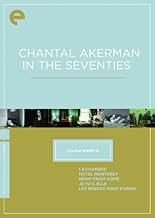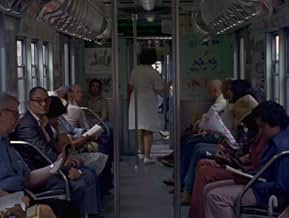News from Home
- 1976
- 1h 29min
Ajouter une intrigue dans votre langueImpersonal and beautiful images of Akerman's life in New York are combined with letters from her loving but manipulative mother, read by Akerman herself.Impersonal and beautiful images of Akerman's life in New York are combined with letters from her loving but manipulative mother, read by Akerman herself.Impersonal and beautiful images of Akerman's life in New York are combined with letters from her loving but manipulative mother, read by Akerman herself.
- Réalisation
- Scénario
- Casting principal
Avis à la une
It's a far piece from the world of Kenyon & Mitchell, but Akerman is not filming events where the attendees might hope to see themselves in a theater. I watched this movie and tried to figure out where each shot was taken. I think I was pretty successful. That game, however, did not take up the whole of the 85 minutes of the movie, and what was someone who was not an adult in Manhattan in the 1970s supposed to do? After ten or fifteen minutes, I decided that the audience was supposed to make of this a portrait of the recipient of the letter, an individual whose mother thinks she is hungry for news of the family, who never writes about whether she is happy or has made any friends (inference: she isn't and hasn't), and the shots are of her world in New York: first downtown near the River, then a long sojourn in the Times Square Subway Station and finally a ten-minute shot from the stern of the Staten Island Ferry setting out of Manhattan.
I think that with this movie, Akerman is trying to rewrite the relationship between film maker and audience. A film maker makes a film that tells a story, and the audience is the perceptive receiver of that tale, whether it is fiction or fact. We infer plot from the course of actions, from the changes in the personality, status, and relationships of the characters. We derive character from the way in which individual performers differ from the stereotyped roles. What, however, are we to make when you don't see the performer, don't hear her voice, except as a hurried reader of letters?
Well, the stereotypical responses fall neatly into two types. The first type says "Dagnabit! I came here to see a movie with interesting characters and a story! This is awful!" The second says "Ahah, this is new and interesting technique. I get what the auteur is trying to do, and approve, because that makes me a smarter, more percipient viewer." Which are you?
As for me, my reaction is "Interesting technique, but I'd prefer a little more effort from the film maker than forcing me to either fall asleep or make up my own story out of rags and tags." That's because I don't insist on a purely conventional story, but rather than being such an intelligent viewer that I get exactly what Akerman is trying to do, I'd like to have some character.
On one hand is the massive city, New York before the makeover in all its brownstone squalor and sleepy routine. The whole film is a series of languid pans of the camera, they capture people waiting in subway stations, a black woman sitting outside on a chair, kids playing in a fire hydrant, street views and Bronx projects, coming and going. If like me, you're drawn to films that wander, you'll be exhilarated to see this.
On the other we have letters that Akerman's mother sent to her while she was in New York as a young girl, she reads these to us in quiet voice-over. She has such a soothing, calm voice. A mother who worries like all mothers do, who wants to know how she's doing, complains that she never writes back, tells about her health and how the store is doing and who got married to whom and that the heat is making her listless.
It's a quietly captivating thing, all in the contrast of exchange between a city that is cold and nameless, vast, and a glad voice from a faraway home that whispers news, love and worries. At one point the engine noise of cars in a four-lane boulevard drowns out a letter being read.
It swims from loneliness to familiarity, because it's all a part of it. And I'm reminded again of how I love seeing America through European eyes. I rank it up there with Varda's Documenteur (it's LA there) as views I'll carry with me, another Belgian, another spirit that wanders freely.
It ends with a long unbroken shot of Manhattan from a ferry vanishing in the distance with seagulls flying overhead. Forget about 'experimental' and 'minimalism', the shots being geometric or not; that's just the brush. A summer was lived.
Chantal's camera records all this squalor in exquisite, non-judgmental long takes. You can almost smell the place. Somehow, the city arranges itself for her in fascinating compositions of color, personalities, and activities. What's that guy over there doing? What is that woman thinking about?
In counterpoint to the visuals, Chantal reads irritating letters from her beloved mother complaining that Chantel does not write frequently enough and When is she coming home? But how could she come home when there is such rich, baroque subject matter for her camera? We know that after her mother died several years later, Chantal committed suicide. The tension between her mother's letters and the power of the city is palpable.
Chantal has left us this gift of a precise record of a time and place that existed once and will not exist again. The final extremely long shot, taken evidently from the Staten Island ferry, is of Manhattan with its Twin Towers still present slowly receding and disappearing in the mist.
Chantal Akerman left her home in Brussels for New York City when she was 20 years old. She lived in NYC for three years. She made some experimental films, and then returned to Brussels. She directed her masterpiece, Jeanne Dielman, 23 quai du Commerce, 1080 Bruxelles in 1975. When she returned to NYC, she returned to her old haunts and made a movie of some of the areas in which she had lived before she was famous.
This film, News from Home, is a series of long takes of scenes in the city. It couldn't have been easy, but she managed to avoid a single striking image of the New York.
Sometimes the camera is still, and we see people walking by. Other times, we peer into deserted diners (think Edward Hopper). Sometimes she records from a moving vehicle. Other times from a subway station platform and then from inside a graffiti-tagged subway car. The last scene shows water--probably shot from the Staten Island ferry.
Think of Rick Steves New York, and then turn around 180 degrees and you get Chantal Akerman's New York. People barely notice her and her cameraperson. She barely notices them.
There's no dialog. There are traffic sounds, but apparently they were dubbed in after the movie was made. What we have instead is Akerman reading letters that her mother sent to her in the early 1970's. The content of the letters fall roughly into three parts: urging Akerman to write and complaining when she doesn't; news from home; desire of her mother that she come back to Brussels.
When Akerman reads the letters, her mother comes across as childish and somewhat pathetic. However, remember that her 20-year-old daughter is living 3,700 miles away, with no steady source of income, and without a working knowledge of English.
As a parent, I say, "Why didn't you write home more often when it meant so much to your mother?" "Why didn't you visit your uncle who lived in New York?" "Why would you want to make this movie?"
There are no breathtaking vistas in this film, so it worked well on the small screen. News from Home has a strong IMDb rating of 7.5. Here's a case where I say, "Did they see the same movie I saw?"
This film came as part of the Criterion Eclipse Series 19-Chantal Akerman in the Seventies. Besides News from Home, this three-DVD set included La Chambre (1972), Hotel Monterey (1972), Je Tu Il Elle (1975), and Les Rendezvous D'Anna (1978). I've reviewed all of them for IMDb.
Le saviez-vous
- AnecdotesWhen Akerman's mother writes her father lost 300,000 francs due to a client's bankruptcy, that would equate to about $8,300 at the time or $38,100 in 2019.
- Citations
Herself - Letter Reader: I received your screenplay. It's well-written, but you know my taste: I find it sad and gloomy. Those people sure have a hard life. It's an important social issue. I hope it will turn out well. The public must be made aware of all this suffering that you young people see so clearly.
- ConnexionsFeatured in What to Watch: Cate Blanchett's Films of Hope (2020)
Meilleurs choix
- How long is News from Home?Alimenté par Alexa
Détails
- Date de sortie
- Pays d’origine
- Langue
- Aussi connu sous le nom de
- Briefe von zu Haus
- Lieux de tournage
- Veselka Restaurant, 144 2nd Ave, Ville de New York, New York, États-Unis(newstand outside with awning in Ukrainian)
- Sociétés de production
- Voir plus de crédits d'entreprise sur IMDbPro
- Durée
- 1h 29min(89 min)
- Mixage
- Rapport de forme
- 1.37 : 1










